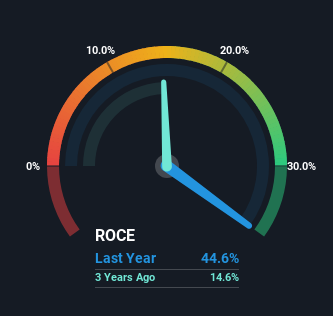- India
- /
- Commercial Services
- /
- NSEI:IRCTC
Why We Like The Returns At Indian Railway Catering & Tourism (NSE:IRCTC)

If we want to find a stock that could multiply over the long term, what are the underlying trends we should look for? Firstly, we'll want to see a proven return on capital employed (ROCE) that is increasing, and secondly, an expanding base of capital employed. Ultimately, this demonstrates that it's a business that is reinvesting profits at increasing rates of return. Speaking of which, we noticed some great changes in Indian Railway Catering & Tourism's (NSE:IRCTC) returns on capital, so let's have a look.
What Is Return On Capital Employed (ROCE)?
If you haven't worked with ROCE before, it measures the 'return' (pre-tax profit) a company generates from capital employed in its business. The formula for this calculation on Indian Railway Catering & Tourism is:
Return on Capital Employed = Earnings Before Interest and Tax (EBIT) ÷ (Total Assets - Current Liabilities)
0.45 = ₹14b ÷ (₹55b - ₹25b) (Based on the trailing twelve months to December 2023).
Thus, Indian Railway Catering & Tourism has an ROCE of 45%. That's a fantastic return and not only that, it outpaces the average of 18% earned by companies in a similar industry.
See our latest analysis for Indian Railway Catering & Tourism

In the above chart we have measured Indian Railway Catering & Tourism's prior ROCE against its prior performance, but the future is arguably more important. If you'd like, you can check out the forecasts from the analysts covering Indian Railway Catering & Tourism for free.
So How Is Indian Railway Catering & Tourism's ROCE Trending?
The trends we've noticed at Indian Railway Catering & Tourism are quite reassuring. Over the last five years, returns on capital employed have risen substantially to 45%. The company is effectively making more money per dollar of capital used, and it's worth noting that the amount of capital has increased too, by 183%. So we're very much inspired by what we're seeing at Indian Railway Catering & Tourism thanks to its ability to profitably reinvest capital.
In another part of our analysis, we noticed that the company's ratio of current liabilities to total assets decreased to 44%, which broadly means the business is relying less on its suppliers or short-term creditors to fund its operations. This tells us that Indian Railway Catering & Tourism has grown its returns without a reliance on increasing their current liabilities, which we're very happy with. However, current liabilities are still at a pretty high level, so just be aware that this can bring with it some risks.
What We Can Learn From Indian Railway Catering & Tourism's ROCE
To sum it up, Indian Railway Catering & Tourism has proven it can reinvest in the business and generate higher returns on that capital employed, which is terrific. Since the stock has returned a staggering 146% to shareholders over the last three years, it looks like investors are recognizing these changes. With that being said, we still think the promising fundamentals mean the company deserves some further due diligence.
If you want to continue researching Indian Railway Catering & Tourism, you might be interested to know about the 1 warning sign that our analysis has discovered.
If you want to search for more stocks that have been earning high returns, check out this free list of stocks with solid balance sheets that are also earning high returns on equity.
New: AI Stock Screener & Alerts
Our new AI Stock Screener scans the market every day to uncover opportunities.
• Dividend Powerhouses (3%+ Yield)
• Undervalued Small Caps with Insider Buying
• High growth Tech and AI Companies
Or build your own from over 50 metrics.
Have feedback on this article? Concerned about the content? Get in touch with us directly. Alternatively, email editorial-team (at) simplywallst.com.
This article by Simply Wall St is general in nature. We provide commentary based on historical data and analyst forecasts only using an unbiased methodology and our articles are not intended to be financial advice. It does not constitute a recommendation to buy or sell any stock, and does not take account of your objectives, or your financial situation. We aim to bring you long-term focused analysis driven by fundamental data. Note that our analysis may not factor in the latest price-sensitive company announcements or qualitative material. Simply Wall St has no position in any stocks mentioned.
About NSEI:IRCTC
Indian Railway Catering & Tourism
Engages in the provision of catering and hospitality, Internet ticketing, travel and tourism, and packaged drinking water services in India.
Flawless balance sheet with moderate growth potential.

